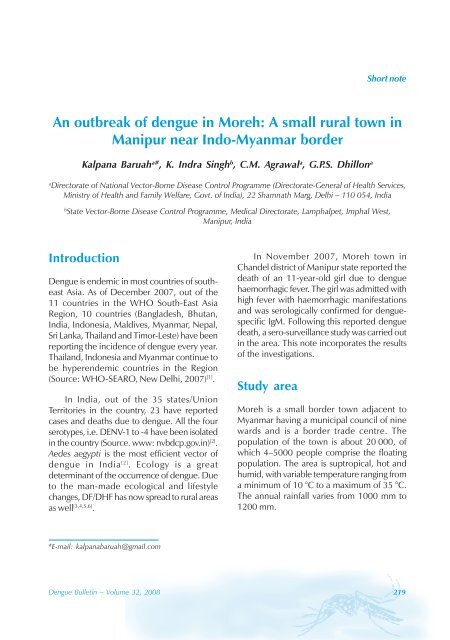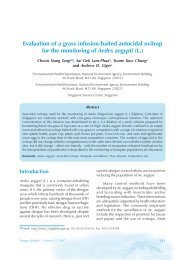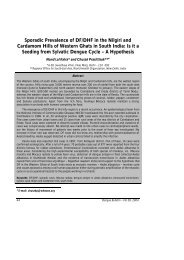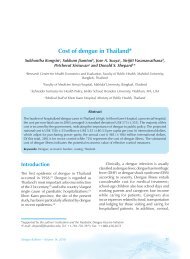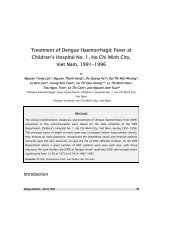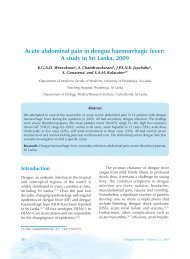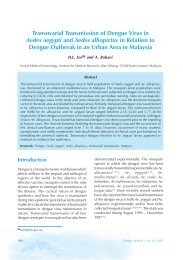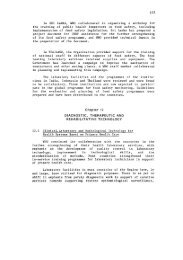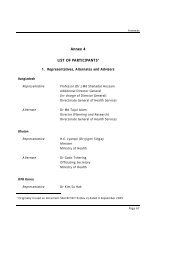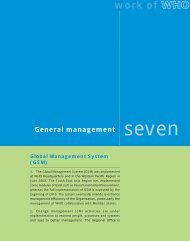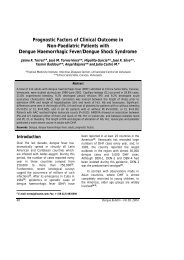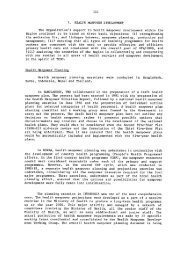0 Acknowledgements.pmd - WHO SEAR Digital Repository
0 Acknowledgements.pmd - WHO SEAR Digital Repository
0 Acknowledgements.pmd - WHO SEAR Digital Repository
Create successful ePaper yourself
Turn your PDF publications into a flip-book with our unique Google optimized e-Paper software.
Short noteAn outbreak of dengue in Moreh: A small rural town inManipur near Indo-Myanmar borderKalpana Baruah a# , K. Indra Singh b , C.M. Agrawal a , G.P.S. Dhillon aaDirectorate of National Vector-Borne Disease Control Programme (Directorate-General of Health Services,Ministry of Health and Family Welfare, Govt. of India), 22 Shamnath Marg, Delhi – 110 054, IndiabState Vector-Borne Disease Control Programme, Medical Directorate, Lamphalpet, Imphal West,Manipur, IndiaIntroductionDengue is endemic in most countries of southeastAsia. As of December 2007, out of the11 countries in the <strong>WHO</strong> South-East AsiaRegion, 10 countries (Bangladesh, Bhutan,India, Indonesia, Maldives, Myanmar, Nepal,Sri Lanka, Thailand and Timor-Leste) have beenreporting the incidence of dengue every year.Thailand, Indonesia and Myanmar continue tobe hyperendemic countries in the Region(Source: <strong>WHO</strong>-<strong>SEAR</strong>O, New Delhi, 2007) [1] .In India, out of the 35 states/UnionTerritories in the country, 23 have reportedcases and deaths due to dengue. All the fourserotypes, i.e. DENV-1 to -4 have been isolatedin the country (Source. www: nvbdcp.gov.in) [2] .Aedes aegypti is the most efficient vector ofdengue in India [2] . Ecology is a greatdeterminant of the occurrence of dengue. Dueto the man-made ecological and lifestylechanges, DF/DHF has now spread to rural areasas well [3,4,5,6] .In November 2007, Moreh town inChandel district of Manipur state reported thedeath of an 11-year-old girl due to denguehaemorrhagic fever. The girl was admitted withhigh fever with haemorrhagic manifestationsand was serologically confirmed for denguespecificIgM. Following this reported denguedeath, a sero-surveillance study was carried outin the area. This note incorporates the resultsof the investigations.Study areaMoreh is a small border town adjacent toMyanmar having a municipal council of ninewards and is a border trade centre. Thepopulation of the town is about 20 000, ofwhich 4–5000 people comprise the floatingpopulation. The area is suptropical, hot andhumid, with variable temperature ranging froma minimum of 10 °C to a maximum of 35 °C.The annual rainfall varies from 1000 mm to1200 mm.#E-mail: kalpanabaruah@gmail.comDengue Bulletin – Volume 32, 2008 219
An outbreak of dengue in MorehTable: Results of sero-surveillance of febrile casesMaleFemaleTotalAge groupSamples IgM positive Samples IgM positive Samples IgM positivetested for dengue tested for dengue tested for dengue0-5 years 9 1 6 0 15 15-14 years 35 5 36 3 71 8Above14 years 84 21 111 21 195 42Total 128 27 153 24 281 51ResultsSero-surveillanceBlood samples were collected from 281clinically-suspected dengue cases with durationof ≥5 days for serological confirmation of DENV.Out of the 281 samples tested, 51 were foundpositive for DENV by IgM Mac ELISA. Foranalyses of the cases, all the 281 cases weredivided into three age groups 0 to 5 years, 5.1to 14 years, and above 14 years. The resultsare given in the Table. There was no significantdifference in the prevalence of the diseaseamong the three age groups (p=0.07797 at5%), indicating fresh introduction of the virusinfecting all age groups in the absence ofimmunity. Furthermore, when the cases wereanalysed for disease prevalence among children0 to 14 years against those aged 14.1 yearsand above, the findings revealed significantdifferences in the prevalence among both theage groups (p=0.02645 at 5%). The prevalencewas significantly higher in the age group above14 years. Thus, the probability of extradomiciliarytransmission of dengue at the worksite (border areas, trade centres) in the affectedareas cannot be ruled out. Both sexes wereequally affected. There was no significantdifference in the prevalence of the diseaseamong males and females (p=0.2415 at 5%).Among the 51 serologically-positive cases,haemorhagic manifestation was observed in 2%of the cases.This is the first report of DF/DHF outbreakfrom Manipur, a state in the north-eastern part ofIndia, with 51 serologically-confirmed denguecases and 9.6% DHF cases. However, dengue isrampant in the bordering country of Myanmar [1] .Since the area is endemic for both Ae.aegypti and Ae. albopictus, it is desirable toundertake comprehensive entomologicalstudies to establish the breeding habitats ofboth the species indoors and outdoors and toidentify the areas of overlap and/or co-breeding.This information is essential for developing anyvector control strategies in the state.<strong>Acknowledgements</strong>The authors are grateful to the state healthauthorities of Manipur and the Regional Officeof Health and Family Welfare, Imphal, foreffectively controlling the DF/DHF outbreak.The help of the Director, Regional MedicalResearch Centre (NE), Indian Council ofMedical Research, is gratefully acknowledgedfor sero-surveillance and laboratory confirmationof the febrile cases as apex referral laboratory.220 Dengue Bulletin – Volume 32, 2008
An outbreak of dengue in MorehReferences[1] Editorial. Dengue Bulletin. 2007 Dec; 31.[2] National Vector Borne Disease ControlProgramme (NVBDCP), Directorate-Generalof Health Services, Ministry of Health & FamilyWelfare, Govt. of India. Web site: http://www.nvbdcp.gov.in/ - accessed 20 June 2009[3] Abdul Kader MS, Kandaswamy P, AppavooNC, Anuradha. Outbreak and control ofdengue in a village in Dharamapuri, TamilNadu. Journal of Communicable Diseases.1967; 29 (1): 69-71.[4] Ilkal MA, Dhanda V, Hassan MM, Mavale M,Mahadev PV, Shetty PS, Guttikar SN, BanerjeeK. Entomological investigations duringoutbreaks of dengue fever in certain villages inMaharashtra state. Indian Journal of MedicalResearch. 1991; 93: 174-8.[5] Katyal R, Gill KS, Kumar K. Breeding of Aedesaegypti and its impact on dengue/DHF in ruralareas. Dengue Bulletin. 1997; 21: 93-5.[6] Baruah K, Kumar A, Meena VR. Entomologicalinvestigations for DF/DHF in Alwar district,Rajasthan, India. Dengue Bulletin. 2004; 28:213-5.Dengue Bulletin – Volume 32, 2008 221


